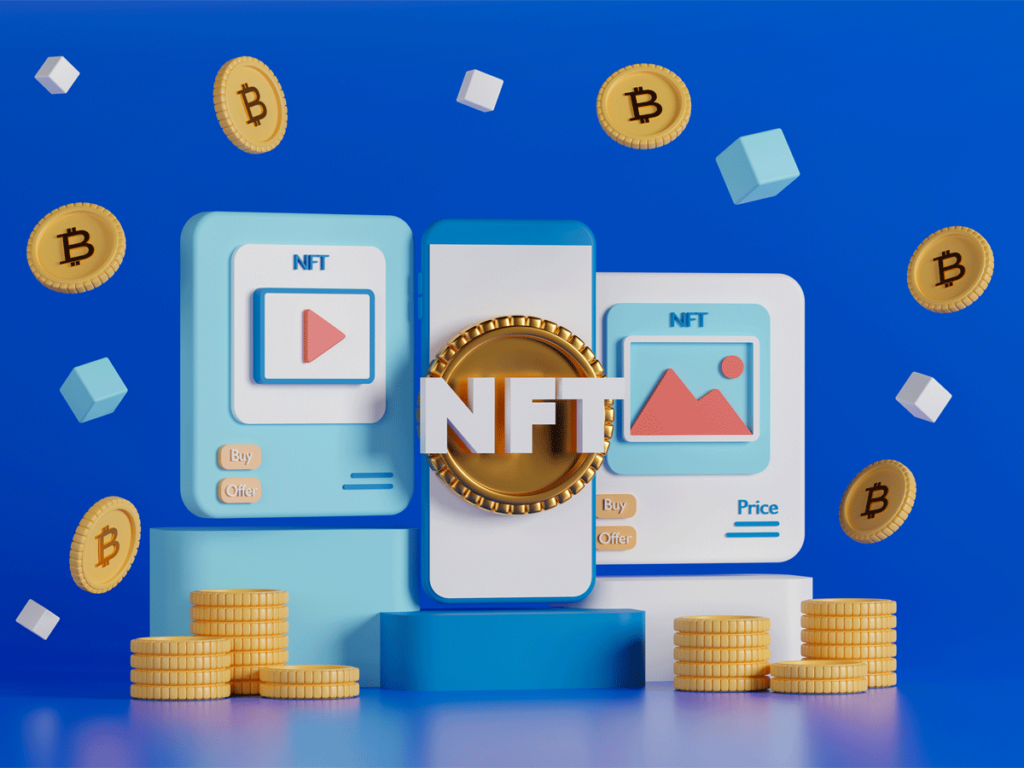Seize Your Future: Ride the NFT Wave to Unprecedented Prosperity!

Understanding Non-Fungible Tokens (NFTs)
Non-fungible tokens (NFTs) signify assets transformed into blockchain-based tokens. These tokens possess unique identifiers generated through metadata and encryption, stored on a blockchain. While the assets themselves are held elsewhere, the bond between the token and the asset ensures their distinctiveness.
NFTs are tradable commodities, exchanging hands for currency, cryptocurrencies, or other NFTs, dictated by market and owner valuation. For example, envision drawing a smiley face on a banana, capturing an image (with metadata), and tokenizing it on a blockchain. Ownership rights, represented by the token, belong to whoever controls the private keys associated with it.
Distinguishing from cryptocurrencies, which are fungible tokens, NFTs on the same blockchain may appear identical but are not interchangeable. Each NFT retains its uniqueness despite similarities in appearance.
Tracing the History of Non-Fungible Tokens (NFTs)
Before gaining mainstream traction, NFTs had a pre-existing history. The inaugural sale reportedly occurred in 2014 with “Quantum,” crafted and tokenized by Kevin McKoy on the Namecoin blockchain, later minted on Ethereum, and sold in 2021.
NFT development adheres to standards like ERC-721 (Ethereum Request for Comment #721), governing ownership transfer, transaction verification methods, and secure transfer protocols. Subsequent enhancements, like the ERC-1155 standard, refined the process, amalgamating multiple NFTs into a single contract, thereby curbing transaction costs.

Unraveling the Mechanics of NFTs
NFTs originate via minting, encrypting asset details recorded on the blockchain. This involves creating a new block, validating NFT data, and finalizing the block—a process often incorporating smart contracts to manage ownership and transfer protocols.
Each minted token is assigned a unique identifier tied directly to a blockchain address, publicly disclosing ownership information. Despite multiple NFTs representing the same item, each possesses a distinct identifier, akin to individual tickets for a movie screening.
Though various blockchains can mint NFTs, terminology may vary. For instance, the Bitcoin blockchain refers to them as Ordinals. Functionally akin to Ethereum’s NFTs, Bitcoin Ordinals are purchasable, tradable assets, with each representing a unique identifier linked to satoshis (the smallest Bitcoin denomination).
Blockchain Dynamics and Fungibility
Cryptocurrencies, akin to physical currency, typically exhibit fungibility, allowing seamless trading or exchange. Conversely, NFTs challenge this paradigm by imbuing each token with uniqueness and irreplaceability, rendering one NFT incomparable to another. Analogous to digital passports, NFTs encapsulate a distinctive, non-transferable identity, facilitating asset differentiation. Additionally, they’re extendable, enabling the fusion of NFTs to birth entirely new ones—a phenomenon dubbed “breeding” within the cryptocurrency sphere.

Exploring NFT Use Cases
Cryptokitties exemplify a prominent NFT use case, emerging in November 2017 as unique digital cat representations on Ethereum’s blockchain. Each cryptokitty boasts distinct attributes and values, reproducing to create offspring with varied traits and worth.
Initially centered around digital art and collectibles, the NFT market expanded, encompassing diverse categories on platforms like OpenSea:
- Photography: Tokenized photography offering total or partial ownership, exemplified by collections like “Ocean Intersection.”
- Sports: Digital art collections featuring celebrities and sports figures.
- Trading cards: Tokenized digital trading cards, ranging from collectibles to in-game assets.
- Utility: NFTs representing memberships or unlocking benefits.
- Virtual worlds: Ownership tokens for avatar accessories or digital real estate.
- Art: A broad category encompassing pixel art to abstract creations.
- Collectibles: Notable examples include Bored Ape Yacht Club, Crypto Punks, and Pudgy Panda.
- Domain names: NFTs signifying ownership of website domains.
- Music: Artists tokenize their music, granting buyers specified rights.
Advantages of NFTs
NFTs offer enhanced market efficiency by streamlining asset tokenization processes and circumventing intermediaries. They facilitate direct connections between sellers and buyers, particularly in art transactions, provided artists understand secure NFT hosting methods.
Moreover, NFTs streamline investment avenues, as evidenced by Ernst & Young’s NFT solution for fine wine investors, leveraging blockchain to safeguard provenance. Real estate tokenization simplifies property trading, while NFTs representing business ownership mimic stock functionality, with smart contracts automating ownership transfers.
Security is a paramount benefit, with NFTs fortifying identity protection by storing personal data on immutable blockchains, impervious to unauthorized access or theft. Furthermore, fractionalizing physical assets democratizes investing, enabling shared ownership and diversification.

Acquiring NFTs
Purchasing NFTs typically entails utilizing supported cryptocurrencies on designated exchanges. Platforms like OpenSea accept various cryptocurrencies like ETH, WETH, AVAX, USDC, and DAI. Alternative marketplaces like Rarible and SuperRare offer additional avenues for NFT acquisition.
Ensuring NFT Safety
While blockchain-based NFTs are inherently secure, safeguarding associated keys is imperative. The vulnerability lies in key storage software, susceptible to hacking, or the loss/destruction of key-holding devices. Adhering to the blockchain adage, “not your keys, not your coin,” ensures NFT security.
Deciphering Non-Fungibility
Fungibility denotes the interchangeability of goods; however, tokenizing an asset confers uniqueness, rendering it non-fungible. Unlike fungible tokens, non-fungible tokens possess distinct identities, precluding equivalency with other tokens.

In Summation
Non-fungible tokens represent an evolutionary leap within cryptocurrency realms, digitizing asset ownership and trading. While the concept of digital asset representation and unique identification isn’t novel, coupling these with blockchain’s tamper-resistant nature, smart contracts, and automation heralds transformative possibilities within financial infrastructures.



